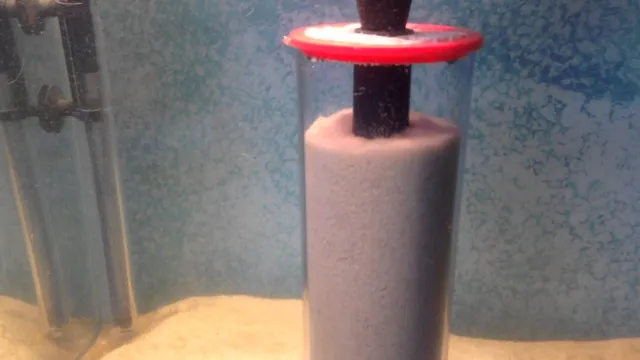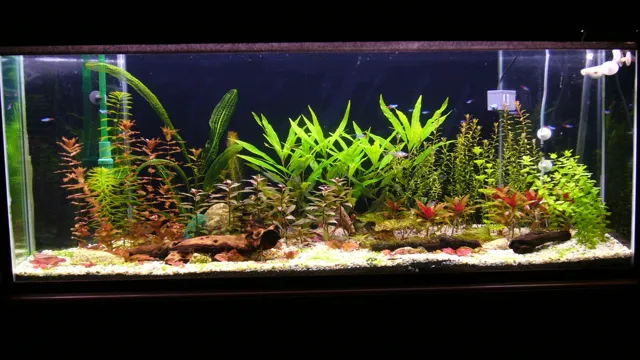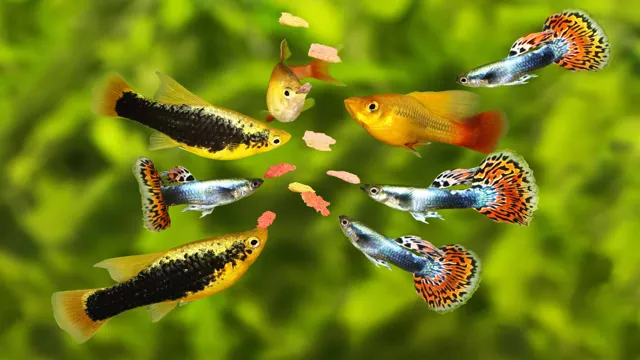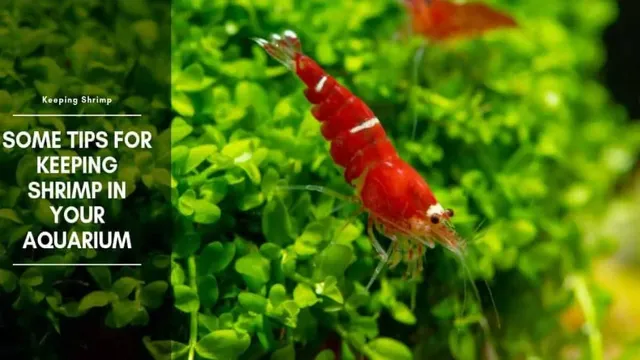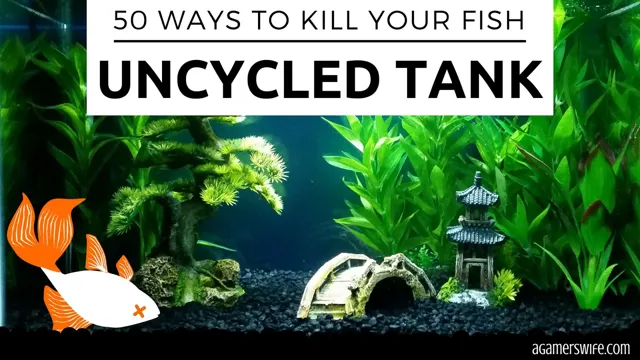Looking to build a 5-gallon sand filter for your aquarium? You’ve come to the right place! Aquarium filters are a crucial component of any aquarium setup, as they help maintain water quality by removing harmful toxins and waste products. Sand filters are particularly effective, as they trap debris and bacteria in the sand bed, keeping your water clear and healthy for your fish. But building your own sand filter might seem daunting.
Where do you even start? Don’t worry, we’ve got you covered. In this blog post, we’ll walk you through the process step-by-step, from choosing the right materials to putting everything together. So grab a cup of coffee, roll up your sleeves, and let’s get building!
Materials Needed
If you’re looking for an easy and inexpensive way to maintain healthy water quality for your aquarium, building a 5 gallon sand filter is a great option. To get started, you’ll need a few materials. You’ll need a 5 gallon bucket with a lid, PVC pipes and connectors, a submersible pump, and sand.
Additionally, you’ll need some tools such as a drill, a saw, and a screwdriver. It’s important to make sure you have all the necessary materials before starting to build the filter to avoid any delays or setbacks. Once you have all the materials ready, you can start building your filtering system and enjoy crystal clear water for your fish.
Five-gallon bucket
If you’re looking to make your own DIY five-gallon bucket project, then you’ll need a few things to help get you started. First and foremost, you’ll need a five-gallon bucket! You can typically find these at your local hardware store or home improvement center. Once you have your bucket, you’ll also need a lid to keep everything inside.
Don’t forget to grab some sandpaper or a sanding sponge to smooth out any rough edges on your bucket and lid. You might also want to pick up some paint or spray paint to add a pop of color to your project. And finally, you may want to grab some accessories like handles or hooks to make your bucket more functional.
With these basic materials, you’ll be well on your way to creating your very own customized five-gallon bucket project that’s both practical and stylish. So, what are you waiting for? Start gathering your supplies today and get ready to make something amazing!
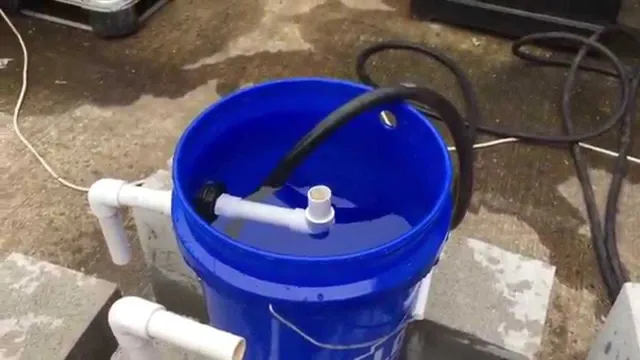
Fine sand
If you are planning on creating a beach-inspired landscape or a sandbox for your kids, you’ll need to consider the type of sand you will be using to achieve the desired look and feel. Fine sand, also known as play sand or sandbox sand, is the perfect material for these types of projects. Fine sand is characterized by its small grains, typically measuring less than 1 millimeter in size.
You can find it at most home improvement stores or landscaping supply stores. When it comes to creating a sandbox or a beach-inspired landscape, there are a few other materials you might need in addition to fine sand. For example, you may require a liner to help contain the sand, as well as some sort of border material like wood or bricks.
Whatever the project, be sure to measure the area you want to cover and purchase enough sand to fill it to the desired depth. With a little planning and the right materials, you can create a beautiful and functional outdoor space that everyone in the family will enjoy!
Screen or mesh
When it comes to screen printing, one important aspect to consider is the type of screen or mesh to use. While there are many options out there, the two most common materials are polyester and nylon. Polyester mesh is a popular choice due to its durability and resistance to stretching, making it ideal for printing designs with fine lines or intricate details.
Nylon mesh, on the other hand, is known for its ability to hold more ink and create a softer print. Ultimately, the choice between these materials depends on the specific design and desired outcome. In addition to the mesh material, other materials needed for screen printing include a frame, emulsion, ink, and a squeegee.
It’s important to invest in good quality materials to ensure the best results for your prints. With the right materials and techniques, screen printing can be a fun and rewarding way to bring your designs to life.
Drill
When it comes to drilling, the materials needed can vary depending on the type of project. Some basic materials include a drill bit, drill machine, safety glasses, and earplugs. Drill bits come in different sizes and shapes, including spade, twist, and masonry bits, and are selected based on the project requirements.
The drill machine should have enough power to handle the chosen drill bit. Safety glasses protect the eyes from flying debris that may result from drilling, while earplugs help reduce noise levels. For larger projects, a drill press may be necessary to ensure precision and accuracy in drilling.
It is essential to invest in high-quality materials to ensure safety and reliability, and having the necessary tools available can make drilling a more manageable task.
Rubber gasket
If you’re looking to make a strong and durable rubber gasket, there are a few materials you’ll need to gather. Firstly, you’ll need high-quality rubber sheets with a thickness that is suitable for your project, as well as a sharp utility knife or pair of scissors for cutting it down to size. It’s also important to have a ruler on hand to ensure precise measurements, and a straight edge to guide your cutting.
For adhesion, you’ll need a suitable adhesive that is compatible with rubber, such as silicone glue or rubber cement. Lastly, it’s always a good idea to have some rubbing alcohol handy to clean the surface area before applying the adhesive, ensuring strong adhesion and a longer-lasting gasket. With the right materials and a little bit of patience, you’ll be able to create a high-quality rubber gasket that will stand the test of time.
PVC pipe and fittings
If you are looking to use PVC pipes and fittings, then there are certain materials that you will need to ensure that your project is successful. Firstly, you will need to obtain PVC pipes of the correct size and length for your project. You can find these pipes at any hardware or home improvement store.
Along with the pipes, you will also need PVC fittings to connect and secure them together. These fittings come in various shapes and sizes such as elbows, tees, couplings, and adapters. It’s essential to choose the right fittings, as they will dictate the shape and functionality of your project.
You will also need PVC primer and solvent cement that will help ensure a secure and leak-free connection of the pipes and fittings. PVC primer helps to clean the surfaces of the pipes and fittings, while the solvent cement helps to fuse them together. With these essential materials, you can confidently embark on your PVC project and create a durable and reliable construction that will last for years to come. (See Also: How to Make Water in Aquarium Clear: 7 Effective Tips for Crystal Clear Aquarium Water)
Water pump
When it comes to installing a water pump, there are a few materials that you’ll need to ensure a successful installation. First and foremost, you’ll need the pump itself. Make sure to choose the right size for your specific needs, and that it’s designed for the type of water you’ll be pumping.
You’ll also need piping to connect the pump to your water source and destination. Make sure to choose piping made from a durable material that can withstand the pressure and flow of the water. Additionally, you’ll need fittings to connect the piping to the pump and any other necessary components.
Other materials you might need could include a pressure tank, a check valve, and an electrical supply for the pump. With these materials in hand, you’ll be well on your way to a successful water pump installation.
Activated charcoal
Activated charcoal is becoming increasingly popular due to its wide range of benefits, including detoxifying properties and teeth whitening. To use activated charcoal, there are a few materials you will need. Firstly, you will need activated charcoal powder, which can be found at health food stores or online.
You will also need a mixing bowl, a spoon, and a toothbrush (if using for teeth whitening). If using for detoxifying purposes, you will need water or another fluid to mix the charcoal powder into a paste consistency. Additionally, you may want to use a towel or something to protect your clothing or countertops, as activated charcoal can be messy.
Overall, using activated charcoal can be a simple and effective way to improve your overall health and appearance.
Filter floss
Filter floss is an essential tool for maintaining a clean and healthy aquarium. This handy material is designed to capture and remove the fine debris that can accumulate in your tank, such as uneaten food, dead plant matter, and fish waste. To use filter floss effectively, you will need a few key materials.
First, you will need a filter media bag or mesh to contain the floss and keep it from getting sucked into the filter itself. You will also need enough floss to fill the bag or mesh, typically one to two handfuls depending on the size of your filter. It’s important to replace the floss regularly, as it can become clogged and lose its effectiveness over time.
By keeping filter floss on hand and using it as needed, you can ensure that your aquarium stays clean and your fish remain healthy and happy.
Steps to Build a 5 Gallon Sand Filter
If you’re looking to build your own 5 gallon sand filter for your aquarium, it’s actually quite a simple process. First, gather all the necessary materials, which include a 5 gallon bucket, mesh screen or filter bag, aquarium sand or silica sand, and a small submersible pump. Begin by drilling small holes into the bottom of the bucket to allow for water flow.
Then place the mesh screen or filter bag into the bottom of the bucket, followed by the sand. Fill the bucket with water and allow the sand to settle, then attach the submersible pump to the top of the bucket and secure it in place. Make sure to adjust the pump flow to an appropriate level for your aquarium size, and test the water chemistry regularly to ensure optimal filtration.
With a bit of DIY spirit and some basic tools, you can have an efficient and affordable sand filter for your aquarium in no time.
Step 1: Drill Holes in the Bucket
Building a 5-gallon sand filter is an affordable and effective way to purify water at home. Step 1 in the process involves drilling holes in a plastic bucket. This is where the water will enter the filter.
Start by selecting a drill bit that matches the size of tubing you will be using. Then, drill several holes into the bottom of the bucket, making sure they are evenly spaced and located away from the edges. You can also drill small holes in the lid to allow for air flow.
But be careful not to drill through the entire lid as this will impact the filter’s effectiveness. Once complete, your bucket is ready for the next step in creating a homemade water filtration system. By following these simple steps, you can purify water efficiently and affordably, all while protecting your health.
Step 2: Install the Rubber Gasket and PVC Fittings
Now that you have prepared the bucket and cut the PVC pipes to the required size, it’s time to install the rubber gasket and PVC fittings to complete the sand filter. Firstly, take the rubber gasket and fit it inside the bucket opening. Ensure that it fits tightly and snugly by pressing it firmly onto the rim.
Next, take the male adapter and screw it onto the threaded end of the bulkhead fitting. Then, attach the female adapter to the other side of the bulkhead fitting. You can use PVC cement to secure the fittings if needed.
Now, connect the male adapter to the PVC pipe that leads to the water pump, and connect the female adapter to the PVC pipe that leads to the pool. It’s important to make sure that all connections are tight and secure to prevent leaks. Congratulations, you have successfully installed the rubber gasket and PVC fittings to build your own 5-gallon sand filter!
Step 3: Install the Screen or Mesh
In order to complete our 5-gallon sand filter, we now move on to the third step, which is installing the screen or mesh. This step is crucial, as it prevents any sand or debris from entering the filter’s outlet. Whether you choose to use a screen or mesh, make sure it fits tightly over the opening of the filter. (See Also: How to Do Aquarium Stomach Trick: A Complete Guide to Impressing Your Friends)
A screen is ideal if you want to achieve a finer filtration, while a mesh is more durable and can withstand the weight of the sand as you pour it in. Whichever you choose, attach it securely to the filter using a zip tie or a tight-fitting screw. Once this is done, you can proceed to add the sand to the filter.
Remember to use sand that is specifically designed for pools, as this will ensure excellent water filtration. This step is critical in ensuring that your filter traps all the smallest debris, so make sure you do not skip it. With that said, we move on to the next step, which is adding the sand.
Step 4: Add the Sand and Charcoal
In step 4 of building our 5-gallon sand filter, we need to add a layer of sand followed by activated charcoal. The sand layer should be about 2-3 inches thick and should be added slowly to ensure even coverage. Once the sand is added, we can then add a layer of activated charcoal.
Charcoal is added to the filter as a means of removing any impurities in the water. It is important to note that only activated charcoal should be used for this purpose, as regular charcoal can actually create more impurities in the water. The charcoal layer should be about an inch thick and should also be spread evenly across the sand layer.
Once both layers are added, we can then move on to the final step of assembling the filter. With the sand and charcoal layers in place, our 5-gallon sand filter is well on its way to cleaning our water supply effectively and efficiently.
Step 5: Install the Water Pump
Now that you have completed the previous steps, the next step in building your 5-gallon sand filter is to install the water pump. This is an essential part of the filtration system as it will circulate the water through the sand bed, trapping the impurities and leaving you with cleaner water. Start by positioning the pump in the bottom of the container, making sure that it is centered and level.
Next, attach the hoses to the inlet and outlet of the pump and secure them with clamps. Make sure that the hoses are long enough to reach the sand bed and that they are firmly attached. Once the pump is in place and the hoses are secure, fill the container with water until it covers the pump.
Turn the pump on and let it run for a few minutes to ensure that it is working correctly. The pump may need to be adjusted to achieve the desired flow rate. Congratulations! You have successfully installed the water pump in your 5-gallon sand filter, and you are one step closer to having crystal clear water.
Step 6: Add the Filter Floss
Once you’ve added the gravel to the sand filter, the next step is to add the filter floss. Filter floss, also known as filter wool, is a fine fiber material that traps smaller particles that may have passed through the gravel. It’s an important part of the filtration process because it ensures that the water that comes out of the filter is clean and clear.
To add the filter floss, simply open the package and fluff it up a bit. Then, place the filter floss on top of the gravel layer. The layer of filter floss should be about 1 inch thick.
Don’t worry about packing it down too much – you want water to flow freely through the floss. The filter floss should be changed periodically depending on how much water you’re filtering and how dirty the water is. With the filter floss in place, your sand filter is nearly complete.
All that’s left to do is add the sand.
Maintaining the Sand Filter
If you’re searching for a low-cost and eco-friendly way to filter your aquarium water, building a 5-gallon sand filter may be right up your alley. However, with any type of filtration system, maintenance is key to its longevity and efficiency. To keep your sand filter working effectively, it’s important to regularly clean and replace the sand.
A good rule of thumb is to replace the sand every six months, or when you begin to notice a decrease in water flow. Additionally, you can extend the life of your sand by rinsing it thoroughly with tap water before placing it into the filter. It’s also crucial to monitor the water quality and check the filter for clogs or damage.
With proper maintenance, your 5-gallon sand filter can provide your aquarium with clear and healthy water for years to come.
Check the pump regularly
Maintaining your sand filter is essential to keep your pool clean and healthy for use. One of the most important aspects of maintaining your sand filter is regularly checking the pump. This is because the pump is responsible for pushing water through the sand, which is what removes debris and contaminants from your pool.
If the pump is not working correctly, it can cause the sand to clog up, and the filter will not work effectively. To ensure that the pump is functioning correctly, you should inspect it regularly and look out for any signs of wear and tear or damage. It’s also important to keep the area around the pump free from debris and ensure that the pump basket is empty and clean.
By taking these simple steps, you can ensure that your sand filter is working correctly, and your pool stays clean and healthy for use.
Clean the filter media periodically
Maintaining a sand filter is crucial to ensure that it functions properly and effectively. One essential aspect of sand filter maintenance is cleaning the filter media periodically. As the filter operates, dirt and debris accumulate on the sand, which affects the filter’s ability to trap particles effectively.
Over time this buildup can cause increased pressure within the filter, potentially leading to damage to the filter and pump. By cleaning the filter media periodically, you can avoid these issues and keep your filter functioning optimally. Start by turning off the pump and closing the valves before removing the filter lid. (See Also: How to Maintain Fish in Aquarium Without Feeding: A Complete Guide)
Carefully remove the filter media and rinse it thoroughly with a hose or pressure washer. After rinsing, return the clean filter media to the filter and reassemble the unit. Regularly cleaning your sand filter media is a vital part of keeping the pool water clean and clear throughout the swimming season.
Make it a habit to ensure your pool is always in top working condition.
Replace filter floss and activated charcoal as needed
Maintaining a sand filter is essential for keeping your pool water clean and clear. One of the crucial things you need to do is to replace the filter floss and activated charcoal as needed. Floss is responsible for trapping large debris, while activated charcoal removes smaller particles and impurities.
As you use your pool, the filter floss and charcoal will start to break down and lose effectiveness, causing the filter to become less efficient. To prevent this, it is recommended to replace the filter floss at least every 4 to 6 weeks and the activated charcoal every 6 to 12 months. Regularly replacing these materials will ensure that your filter is functioning optimally and your pool water stays crystal clear.
Neglecting to change them could result in cloudy, dirty water that can be harmful to swim in. So don’t forget to keep an eye on your filter’s performance and replace the floss and charcoal as needed to maintain a healthy and beautiful pool.
Conclusion
In conclusion, building a 5-gallon sand filter for your aquarium may seem like a daunting task, but with the right materials and a little bit of elbow grease, it can be done! Not only will your fish enjoy crystal clear water, but you’ll also get some satisfaction out of knowing you created a DIY masterpiece. So roll up your sleeves, put on your thinking cap, and get ready to show off your aquatic engineering skills to all your fish keeping friends. After all, when it comes to building sand filters, there’s nothing fishy about it!”
Building a 5-gallon sand filter for your aquarium is a simple project that can greatly improve water quality.
Once you’ve set up your 5-gallon sand filter, the next step is to maintain it properly. The frequency of maintenance will depend on the size of your aquarium and the number of fish you keep. Generally, it is recommended to clean the filter every three to four weeks.
Start by unplugging the filter from the power source and taking it out of the tank. Dispose of the dirty sand and rinse the container thoroughly with water. Refill the container with clean sand and place the filter back into the aquarium.
You can also add some beneficial bacteria to the sand filter to promote healthy water conditions. Remember to also regularly replace any disposable filter media and clean the filter pump. By taking care of your sand filter, you’ll be providing your fish with a clean and healthy living environment.
FAQs
What materials do I need to build a 5 gallon sand filter for my aquarium?
To build a 5 gallon sand filter for your aquarium, you will need a plastic container, aquarium tubing, activated carbon, and aquarium sand.
How do I assemble the filter once I have all the materials?
First, drill holes in the bottom of the plastic container, then layer the activated carbon and aquarium sand in the container. Finally, attach the aquarium tubing to the container to create an inlet and outlet for the water.
How often do I need to clean my 5 gallon sand filter?
It is recommended to clean your 5 gallon sand filter every 2-4 weeks, depending on the size of your aquarium and number of fish.
Can I use this sand filter for other types of aquariums?
Yes, you can modify the size of the container and amount of materials used to create a sand filter for different sized aquariums.
How does a sand filter benefit my aquarium?
A sand filter can improve water quality by removing debris and harmful toxins from the water, providing a healthy environment for your fish.
Is a sand filter sufficient for maintaining the cleanliness of my aquarium?
While a sand filter is beneficial for water quality, it is not a replacement for regular cleaning and maintenance of your aquarium.
Are there any risks or downsides to using a sand filter?
Improper assembly or cleaning of a sand filter can lead to the buildup of harmful bacteria and even death of fish. It is important to follow proper maintenance and cleaning procedures.

